Bearded Collie Breed Health Survey 2018
Message from Liz Ayrton, Breed Health Co-ordinator:
"A big thank you to everyone who filled in the Breed Health Survey in February 2018 - it was a fabulous response and gave us plenty of data with a total of 1,132 dogs entered. Overall the picture is an encouraging one with many Bearded Collies living on into old age with minimal problems but it also gives us data on areas where we do have problems. Encouraging yearly participation will enable us to monitor these problems and act accordingly and also focus in which areas we use any resources available to us."
Bearded Collie Health Survey 2018
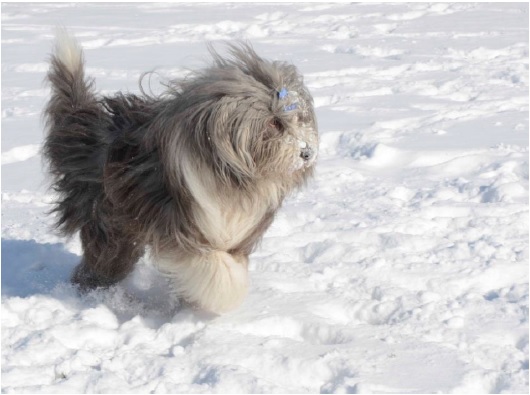
Recent years have shown a steady decline in registration numbers - data from the Kennel Club (Kennel Club, 2018) over the last ten years shows the trend:
| Year | Registration numbers |
|---|---|
| 2008 | 643 |
| 2009 | 528 |
| 2010 | 572 |
| 2011 | 547 |
| 2012 | 480 |
| 2013 | 552 |
| 2014 | 371 |
| 2015 | 346 |
| 2016 | 284 |
| 2017 | 420 |
In 2016 the numbers fell below the 300 mark which meant we were classified as a vulnerable breed by the Kennel Club and although the numbers recovered slightly in 2017 the number of puppies registered has declined substantially. The aim of this survey was to try and obtain health data on as many dogs as possible for the year ending 28-02-2018 and then to repeat the survey on an annual basis so that rather than looking at a single snapshot on health we could monitor the trends and take action as needed. To this end a survey was designed that was not too detailed in order to encourage participation and obtain data on as many dogs as possible to get an accurate picture on the health of the breed. The final survey consisted of twelve questions with either Yes/No answers or short answers and was designed to be user-friendly.
Data was received on 1132 dogs of which five dogs had died in the year leading up to February 2018.
Ages
The age range of Bearded Collies showed a distribution from 12 weeks of age up to 16 years confirming previous studies which have showing that the Bearded Collie can be a very long lived breed. (O'Neill et al., 2013)
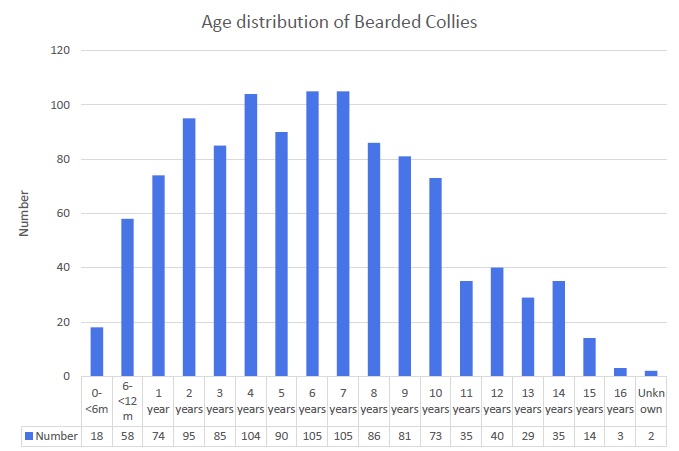
The dogs that had died were distributed across the age range - 4 years, 7 years, 9 years, 10 years and 13 years and had died from a variety of conditions including autoimmune conditions - 2 dogs, tumours - 2 dogs (one had a nasal tumour and the other had a liver tumour) and also a dog that had died at 7 years of an unspecified respiratory issue. For an owner the death of a dog is traumatic at any age but especially so if they are well below their life span ( the dog that died at 4 years had multiple autoimmune problems). This is why we have always been concerned within the breed with autoimmune disease as so far a means in which to try and ensure affected puppies are not bred has eluded us as the disease appears to be multifactorial with no clear genetic mode of inheritance identifiable.
Distribution of sexes and number of dogs neutered

Female dogs represented 52% of the population and male dogs represented 48%. A total of 411 Bearded Collies were neutered representing 36% of the total population. This is much lower than the average neutering rate for pet dogs of 71% (PAW report, 2017) which probably reflects the fact that this survey was distributed widely among many people who breed as well as pet owners and therefore the breeding population was included. Other factors may also be involved such as the fact that neutering can cause coat changes, which is more evident in a long coated breed and there is now increased knowledge of the fact that not all effects of neutering are positive.
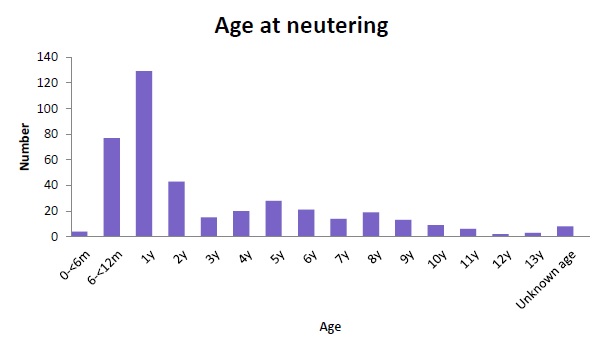
As would be expected in line with most pets neutered the age of neutering was positively skewed with the vast majority of dogs neutered young, there were a small number (8 dogs) where age of neutering was not known either because the owner could not remember or the dog was a rescue dog. Eighty one dogs were neutered at under 12 months of age. Recent research published which appears to be very breed specific is showing in some breeds that there is an increase in orthopaedic problems such as hip dysplasia, elbow dysplasia and cruciate disease in dogs neutered earlier and also certain types of cancer and some behavioural problems. (Hart et al. 2014, Hart et al, 2016 and Zink et al. 2014) Of the dogs neutered under 12 months of age only two (2.5%) reported any orthopaedic problems - one was a female neutered at 10 months which had hip dysplasia but this had already been diagnosed at the time of neutering and the other was a male neutered at 10 months who went on to develop a ruptured cruciate ligament at 3 years of age.
1. Episodes of new disease requiring veterinary attention in the last 12 months.
231 dogs (20.4%) or one in five were reported to have received veterinary attention for one or more new problem in the last 12 months. A total of 266 problems were reported in total.
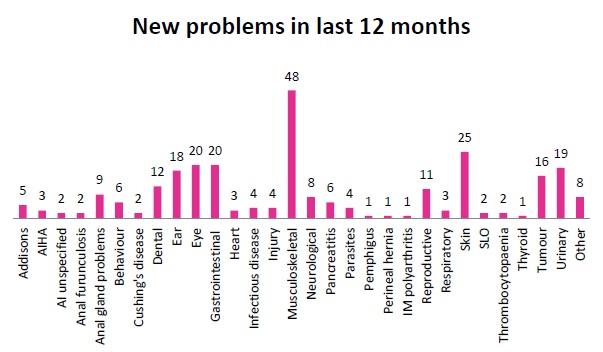
The group of conditions in this group most commonly reported were musculoskeletal conditions with 48 instances reported. These were broken down as follows:
| Musculoskeletal condition | Number of dogs |
|---|---|
| Arthritis | 30 |
| Injuries including torn triceps, torn tendon and a rotator cuff injury. | 4 |
| Foreleg lameness | 4 |
| Cruciate disease | 3 |
| Elbow dysplasia | 2 |
| Spondylitis | 1 |
| Lumbosacral disease | 1 |
| Muscle wastage | 1 |
| Muscle spasm in neck | 1 |
| Unspecified hip problem | 1 |
Immune mediated polyarthritis was not included in this category as although it is a musculoskeletal disease the immune mediated diseases were analysed separately. Given that 231 dogs are aged 10 years and older (20% of the total sample) it is hardly surprising that arthritis is the most common condition reported in this section.
Immune mediated disease
A breakdown of the incidence of immune mediated disease diagnosed in the preceding 12 months is given below.
| Autoimmune disease | Number of cases |
|---|---|
| Addison's | 5 |
| AIHA | 3 |
| Anal furunculosis | 2 |
| Pemphigus | 1 |
| IM polyarthritis | 1 |
| SLO | 2 |
| IM thrombocytopaenia | 2 |
| AI unspecified | 2 |
| Total | 18 |
Autoimmune disease represents 6.8% of the new problems with which dogs were taken to visit their veterinary surgeons in the preceding 12 months. Two of the cases of AIHA and one case of SLO were considered by the owner to have resolved and so had not been entered in the long term health problems listed below.
2. Bearded Collies with long term health problems
196 dogs (17.3%) were reported to be suffering from one or more long term health problems representing 238 long term problems reported.
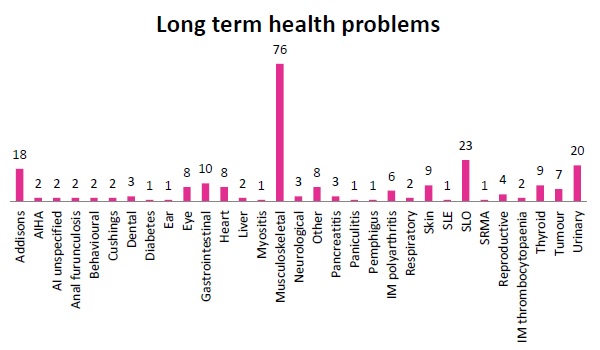
As with new problems the largest category was musculoskeletal disease with 76 reported problems which represents 31.9% or nearly a third of all the long term health problems. Of the musculoskeletal problems 47 of the 76 problems (61.8%) were suffering from arthritis, this represents 4.15% of the total number of dogs in the survey.
| Chronic musculoskeletal condition | Number of dogs suffering |
|---|---|
| Arthritis | 47 |
| Injury | 2 |
| Elbow dysplasia | 13 |
| Vertebral sclerosis | 1 |
| Hip problems unspecified | 2 |
| Hip dysplasia | 3 |
| Weak ligaments | 1 |
| Leg amputation (reason unknown) | 1 |
| Spondylosis | 2 |
| Spondylitis | 1 |
| Cruciate disease | 3 |
It would be expected to have a reasonable incidence of arthritis in a sample where 20% of the dogs are over 10 years of age due to simple wear and tear. More worrying are the diseases that have a multifactorial aetiology including hereditary factors as these often affect young dogs and can lead to a lifetime of problems for both the dog and the owner. These include hip dysplasia and elbow dysplasia. In the present survey, hip dysplasia was given as a chronic disease in only 3 dogs (0.27%) however it could be a factor in some of the cases of osteoarthritis. Assured Breeders in the UK have a mandatory requirement to hip score their dogs before breeding. It is recommended that hip scores should be looked at along with other criteria and ideally the dogs chosen to breed from should have a hip score around or ideally below the breed median score which for the Bearded Collie is currently 9 (BVA/Kennel Club, 2017). The Kennel Club also now publish estimated breeding values (EBV) for hips in the Bearded Collie and the more complete this data becomes the more useful it will be as an additional tool to aid breeders in choosing dogs from which to breed. There is less data on elbow disease as elbow scoring is not mandatory in the breed although there are breeders starting to elbow score for their own information and there are dogs that are showing evidence of the disease. The recommendation is that ideally dogs with a score of 0 should be bred from and certainly not dogs with a score of 2 or 3.(BVA/Kennel Club, 2018) In the current survey there were 13 dogs with a specific diagnosis of elbow dysplasia mentioned as a chronic disease which represents 1.15% of the population, whilst this is not high it bears monitoring as it shows clear evidence of the disease within the breed - this is something that should be watched in subsequent breed health surveys now we have a baseline figure.
Immune mediated disease
As mentioned previously immune mediated diseases have always been of concern in the breed. In the current survey the total number of instances of immune mediated disease in the long term health problems was 60 which represents 25.2% or one in four of all long term health problems mentioned. Breakdown of immune mediated disease is as follows:
| Disease | Number of cases |
|---|---|
| Addison's | 18 |
| AIHA | 2 |
| AI unspecified | 2 |
| Anal furunculosis | 2 |
| Diabetes | 1 |
| Myositis | 1 |
| Pemphigus | 1 |
| Polyarthritis | 6 |
| SLE | 1 |
| SLO | 23 |
| SRMA | 1 |
| IMTP | 2 |
| Total | 60 |
Within the survey the total number of dogs affected with one or more immune mediated diseases was 61 which represents 5.4% of the total dogs in the survey, this includes the dogs that had shown disease but the owners felt it had resolved. This number is generally less than has been reported in other surveys ( Kershaw, Wilkins and Mc Bride, 2015. and Kennel Club, 2014) but may reflect that we had a large sample number and owners of healthy dogs were encouraged to enter data. The sex distribution of these dogs was 51% male and 49% female with a breakdown as follows:
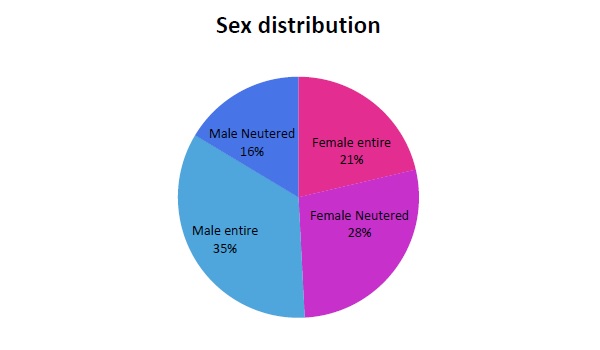
Age of onset of immune mediated disease for these dogs was as follows:

Age of onset is positively skewed showing more young dogs diagnosed which is the reason for concern with these diseases, along with their life threatening nature, the need for ongoing treatment in most cases and the unclear mode of inheritance and their likely multifactorial aetiology.
Disease of the urinary system
There were 20 cases of disease of the urinary system in the long term health problems representing 8.4% of the total problems. The breakdown of disease was as follows:| Disease | Number |
|---|---|
| Crystal/Stone formation | 2 |
| Urinary tract infections | 2 |
| Incontinence | 16 |
Urinary incontinence represented 80% of long term health problems affecting the urinary tract and all cases were in neutered female dogs. The disease is seen in 1.4% of the dogs taking part in the survey which is less than that reported in a recent paper on urinary incontinence in bitches (O'Neill et al., 2017). This probably reflects the difference in methods of collecting data - this is a breed health survey whereas the O'Neill data was collected from dogs visiting veterinary surgeries so the proportion of healthy dogs is likely to be different.
Dogs on long term medication
146 dogs (12.9%) were reported to be on long term medication with one or more drug. A total of 228 instances of long term medication use were reported but of these 58 were dietary supplements, 5 dogs were on dietary modification and one dog was being treated homeopathically leaving only 164 instances of drugs being used to treat dogs. The breakdown of use was as follows:
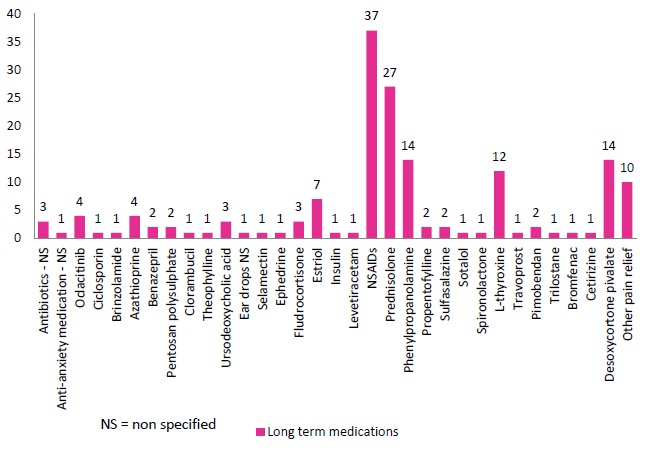
This reflects the finding of earlier in the survey with the largest class of drugs used being non steroidal anti inflammatory drugs which are used to treat musculoskeletal disorders and prednisolone which is used in the treatment of many immune mediated conditions.
Summary
This is the first attempt to collect data on an ongoing basis by yearly health surveys in the breed. The general feedback was the survey was easy and quick to complete although that did not necessarily make it easy to analyse. The ease with which the survey could be completed did mean there was a compromise in the amount of data collected. However, there was a good response with data on 1132 dogs. This showed that although the breed has some health problems in line with many other pure bred dogs Bearded Collies were in general a long lived breed and many of the diseases seen were associated with age. This should not lead to complacency though as dwindling registration numbers leads to a reduction in the number of dogs available for breeding and the danger of loss of genetic diversity especially if many dogs are bred to popular sires. We also still have the problem that we do not know how to prevent the breeding of dogs with immune mediated disease and all we can do at present is not to breed from any dogs exhibiting these diseases, not repeat matings that have produced offspring with these diseases and continue to try and increase genetic diversity and reduce the coefficient of inbreeding of puppies produced. The Joint Breed Liaison Committee and the Breed Clubs are also committed to looking for opportunities to help further research in these areas and have recently funded research looking for auto antibodies in canine diabetes mellitus and canine hypoadrenocorticism as well as taking part in the Give the Dog a Genome project at the Animal Health Trust by part funding the analysis of the genome of a healthy Bearded Collie and one with Addison's disease.
References
British Veterinary Association/Kennel Club (2017) British Veterinary Association/Kennel Club Hip Dysplasia Scheme - Breed specific statistics1st January 20001-31st December 2016. Available from https://www.bva.co.uk/uploadedFiles/Content/Canine_Health_Schemes/hip-dysplasia-breed-specific-statistics-jul-15.pdf [Accessed 15 April 2018]
British Veterinary Association/Kennel Club (2018) Elbow Dysplasia in dogs. Available from https://www.bva.co.uk/uploadedFiles/Content/Canine_Health_Schemes/20180116%20CHS%20Elbow%20Dysplasia%202018%20v1%20web.pdf [Accessed 15 April 2018]
Hart B.L., Hart L.A., Thigpen A.P. and Willits N.H. (2014) Long term health effects of neutering dogs: Comparison of Labrador Retrievers with Golden Retrievers. Plos One 9(7) 1-10.
Hart B.L., Hart L.A., Thigpen A.P. and Willits N.H.(2016) Neutering of German Shepherd Dogs: associated joint disorders, cancers and incontinence. Veterinary Medicine and Science, 2 191-199.
Kennel Club (2018) Pedigree Breed Health Survey 2014. Available from https://www.thekennelclub.org.uk/media/749092/bearded_collie.pdf [Accessed 15 April 2018]
Kennel Club (2018) 10 yearly breed statistics. Available from https://www.thekennelclub.org.uk/media/129021/10yrstatspastoral.pdf [ accessed 15 April 2018]
Kershaw, Wilkins and Mc Bride (2015) Report of the UK Bearded Collie Breed Liaison Committee 2007-2011. Available from http://www.beardedcollieclub.co.uk/docs/health_survey_report2015.pdf [Accessed 15 April 2018]
O'Neill D.G., Church D.B., McGreevy P.D., Thomson P.C. and Brodbelt D.C. (2013) Longevity and mortality of owned dogs in England. The Veterinary Journal, 198, 638-643.
O'Neill D.G., Riddell A., Church D.B., Owen L., Brodbelt D.C. and Hall J.L. (2017) Urinary incontinence in bitches under primary veterinary care in England: prevalence and risk factors. Journal of Small Animal Practice, 58, 685-693.
PDSA,(2017) PAW Report 2017. Available from https://www.pdsa.org.uk/media/3291/pdsa-paw-report-2017_printable-1.pdf [Accessed 09-04-18]
Zink M.C., Farhoody P., Elser S.E., Ruffini L.D., Gibbons T.A. and Rieger R.H. (2014) Evaluation of the risk and age of onset of cancer and behavioural disorders in gonadectomised Vizslas. Journal of the American Veterinary Medical Association 244 (3) 309-319.May 2018

